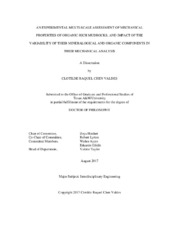| dc.contributor.advisor | Heidari, Zoya | |
| dc.contributor.advisor | Lytton, Robert | |
| dc.creator | Chen Valdes, Clotilde Raquel | |
| dc.date.accessioned | 2018-02-05T21:22:56Z | |
| dc.date.available | 2019-08-01T06:51:26Z | |
| dc.date.created | 2017-08 | |
| dc.date.issued | 2017-09-01 | |
| dc.date.submitted | August 2017 | |
| dc.identifier.uri | https://hdl.handle.net/1969.1/166099 | |
| dc.description.abstract | Reliable evaluation of rock mechanical properties in organic-rich mudrocks is challenging due to their heterogeneity, anisotropy, and complex lithology. It is important to assimilate variable elastic properties and distribution of individual mudrock components, as well as rock fabric in the evaluation of elastic properties of organic-rich mudrocks. Failure to take into consideration their physical and mechanical properties, can result in unreliable geomechanical characterization for wellbore studies and stress prediction for completions design.
The objectives of this dissertation are to (a) investigate the impact of anisotropic poroelastic parameters for stress prediction in organic-rich mudrocks; (b) quantify the uncertainties involved in well-log-based evaluation of effective elastic properties of mudrocks using micro-scale mechanical testing; and (c) evaluate the impacts of thermal maturity on elastic properties of kerogen and on effective elastic properties of mudrocks.
First, I demonstrated that a thorough depth-by-depth estimation of anisotropic poroelastic parameters is required to estimate stress profile for organic-rich mudrocks. I observed variabilities of up to 30% in estimates of minimum horizontal stress due to vertical heterogeneity, mechanical anisotropy and anisotropic poroelasticity assumptions in organic-rich formations. Next, I evaluated the uncertainties involved in the assessment of effective elastic properties of organic-rich mudrocks. I used nanoindentation tests to quantify the variability in elastic properties of individual rock components, caused by differences in their spatial distribution, size, and rock fabric within the formation. I reported a variability of 25% in Young’s moduli of clay minerals due to their location within the mudrock. I also quantified differences up to 33% between estimates of elastic stiffness coefficients from core measurements and well-log-based estimates of effective elastic stiffness coefficients obtained from nanoindentation tests. Finally, I demonstrated that elastic properties of kerogen vary as the thermal maturity of the formation changes. I evaluated the impacts of thermal maturity on elastic properties of kerogen at the micronscale by using synthetic thermal maturation. I reported differences of up to 44% in magnitudes of Young’s moduli of kerogen at different levels of thermal maturity. Furthermore, I observed that effective elastic properties of the formation varied up to 25% as thermal maturity of kerogen changes from room temperature to 425ºC. | en |
| dc.format.mimetype | application/pdf | |
| dc.language.iso | en | |
| dc.subject | Organic rich mudrocks | en |
| dc.subject | anisotropy | en |
| dc.subject | poroelasticity | en |
| dc.subject | nanoindentation | en |
| dc.subject | kerogen | en |
| dc.subject | thermal maturity | en |
| dc.title | An Experimental Multi-scale Assessment of Mechanical Properties of Organic-rich Mudrocks, and Impact of the Variability of Their Mineralogical and Organic Components in Their Mechanical Analysis | en |
| dc.type | Thesis | en |
| thesis.degree.department | College of Engineering | en |
| thesis.degree.discipline | Interdisciplinary Engineering | en |
| thesis.degree.grantor | Texas A & M University | en |
| thesis.degree.name | Doctor of Philosophy | en |
| thesis.degree.level | Doctoral | en |
| dc.contributor.committeeMember | Ayers, Walter | |
| dc.contributor.committeeMember | Gildin, Eduardo | |
| dc.type.material | text | en |
| dc.date.updated | 2018-02-05T21:22:57Z | |
| local.embargo.terms | 2019-08-01 | |
| local.etdauthor.orcid | 0000-0002-5075-114X | |


